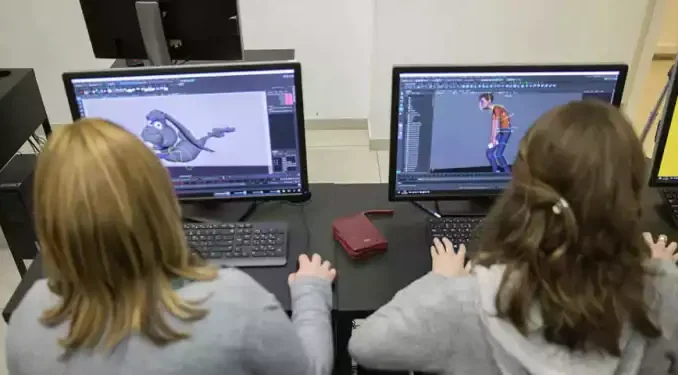The Israel Democracy Institute’s yearbook on the Haredi sector, which has been published for eight years and reviews the changes that have taken place in recent decades in various fields in ultra-Orthodox society, sheds light on just how far along Haredi women have come in joining the workforce.
By Sonia Gorodeisky 01-02-2024 14:09

In recent weeks, the importance of core studies in the Haredi sector has been widely discussed in the context of coalition funds, which include billions of Shekels for Haredi educational institutions that do not teach core studies, thus reducing the chances of Haredi children integrating into the future job market.
In the meantime, data on the ground show a considerable improvement in recent years in some of the numbers related to Haredi education and employment.
So, for example, the number of Haredi students taking matriculation exams – even if they are not entitled to a certificate – rose from 24% in 2008 to 44% in 2021. Within five years, the number of those eligible for matriculation in the Haredi sector increased from 2% to 6% among Haredi males and from 20% to 25% among Haredi females (2016-2021).
This data is based on the 2023 publication of the Israel Democracy Institute’s yearbook on the Haredi sector, which has been published for eight years and reviews the changes that have taken place in recent decades in various fields in Haredi society, including education, employment, and lifestyle.
The survey also shows that at the beginning of 2023, there were approximately 156,036 yeshiva students in the Haredi sector. This was after a year in which the increase of the number of yeshiva students slowed down to 2.5% in 2022, at the end of which the Haredi parties joined the coalition, and increased again by 4.1%.
It must be noted that this number of Haredi yeshiva students includes unmarried men, most of whom are under 23 years old, and married men, most of whom have been studying for many years even over age 31. Institute researchers point out the clear connection between the presence of Haredi parties in the coalition and the growth rate in the number of Haredi yeshiva students. Since 1999, the only years that showed a decrease in this number were 2013-2014.
The Haredi population in Israel numbers approximately 1,335,000 people, which is 13.6% of the total population. Young people up to age 19 comprise 58% of the Haredi population compared to 31% in the general Jewish population. In 2030, the Haredi population is expected to reach 16% of the total population, while there are expected to be about one million Haredim up to the age of 20, who will constitute 25% of this age group.
Technological professions are a top priority
About 16,700 Haredi students, comprising 5% of all students, studied in institutions of higher education in the 2022/23 academic year. Their number increased this year by about 900 students, an increase of 7%. Sixty-nine percent of Haredi students are women.
Another interesting statistic that emerges from this study is that 15% of Haredi female students are studying computer science (compared to 13.5% among non-Haredi female students). This is a jump of 63% in four years. The number of Haredi men studying computer science among all Haredi students is significantly lower than the number of non-Haredi Jewish students (19% versus 28.5%, respectively).
Video: Haredim protest in Beit Shemeh / Credit: Israel Police
Editor of the Haredi society’s yearbook, Dr. Gilad Malach, explains the data in a conversation with Israel Hayom: “The Haredi society is a ‘studying society,’ that directs its sons to focus on learning Torah, and this has led to a dramatic change in the role of women in this society. If a few decades ago they were employed as teachers – today, in order to support the household, they have to work in high-quality positions, in many cases in professions in the field of technology.”
Malach adds: “As a result, the curriculum in Haredi high schools for girls changed rapidly, and now includes English, mathematics, and technological subjects. The training curriculum in the high school seminaries, which in recent years also offers a variety of technological tracks, has changed. Many Haredi women prefer to undergo technological training in a full academic track, generally on a Haredi campus, resulting in a situation where the percentage of women studying computer science is even higher than non-Haredi women.”
Malach went on to say that “this change allows many married yeshiva students to continue studying in yeshiva, and we have therefore seen an increase in recent years in the number of married students that does not fall short of the general rate of growth of the Haredi society. The only cases in which the increase in the number of married yeshiva students was stopped was due to strong economic pressure on the Haredi society, or when support for Torah studying decreased.
New record
Moreover, in 2023, the number of working Haredi women of prime working age crossed the 80% threshold for the first time and jumped to 157,000, an increase from 142,000 last year. To be noted that the 2023 figures are correct for the first three quarters of the year, and it is possible that the final figure for 2023 will be lower, especially among Haredi men, due to the situation in the local economy, alongside coalition funds for Torah institutions.
However, the average monthly income for Haredi men dropped from 76% in 2003 to 50% of the average monthly income among non-Haredi Jews in 2021. In this year, this amount stood at NIS 9,707 compared to NIS 19,279 among non-Haredi Jewish men. In that year, Haredi women earned an average of NIS 8,230 a month, 67% of the average monthly income among non-Haredi Jewish women (NIS 12,330).
A decrease in the incidence of poverty
There has been a decrease in the incidence of poverty among Haredi families from 39% in 2015 to 34% in 2021, a very high figure in comparison to the general population (21% in 2021). It is possible that the decrease is a result of an increase in the employment rate of Haredi women and an increase in the level of income among employees, together with an increase in state support for married yeshiva students and child allowances. In addition, the rate of Haredi children who lived below the poverty line after payments of child allowance was 47% in 2021.
Household income: a 19% increase has been registered in gross monthly income for a Haredi household over a period of six years (from NIS 12,616 in 2015 to NIS 14,978 in 2021), but this amount is still 55% lower than the gross income for a non-Haredi Jewish household (22,047 shekels).
Editors of the Haredi Society Yearbook, Dr. Gilad Malach and Dr. Lee Cahaner, from the Israel Democracy Institute, point out that “there is a clear trend towards a rise in the standard of living of Haredi households, as a result of a rise in the number of working Haredi women and a renewed increase in the rate of working Haredi men after a few years of treading on the same spot.”



Here is another example of the haredi custom of soliciting funds from the haredi public to pay for ta lavish wedding party and a new apartment for the engaged couple.
Someone asked me in relation to this article if I could provide an example of the haredi community’s custom of providing an engaged couple with a lavish wedding and “setting them up” with a new apartment, complete furnishings, and about three months worth of cash, that in haredi culture are all necessary prerequisites for marriage. I finally found an example of this custom on the Hesid Fund site:
https://thechesedfund.com/helping/ztyny?aff=Inner25&utm_source=jewishcontentnetwork&utm_medium=banner. Please read this, who ever is interested in learning about this custom, which doesn;t exist among secular Jews.
@ms 45143. After checking with the Arutz Sheva site, I learned that the name of the charity is “Chesed Today.” For years, it had a different, Hebrew name. But it seems that recentl it changed its name to this English landuage one. I can;t show you any of their usual appeals for engaged couples to be “set up” with a new apartment, furniture and other supplies, because the charity’s focus has now changed, understandably, to raising money for the families of IDF soldiers who are needy, needy Ukrainian Jews, and even Ukrainian non-Jews. Also, Jews imprisoned in Russia. While I approve of this change of focus, it means that I can’t send you the links to charitable appeals from people appealing to donors to help them “marry off” their daughters and “set them up” in their own apartment. Or sometimes the daughters and their betrotheds appeal to donors directly. If Israel ever wins this war or at least is able to scale down military operations, I believe you will see a return of these appeals.
@ms54143. With my increasingly fading memory i can;t recall the name of this charity. But it adverises in nearly every issue of Arutz Sheva, and raises funds from readers there, Its advertisements explain this custom and solicit funds for these young couples. According to these advertisements. these young couples refuse to marry until and unless they receive this funding. Their soliciation advertisements always describe these couples as strictly orthodox and morally worthy individuals.
I will check with Arutz Sheva and get back to you with the name of the fund.
This report is missing a lot of things. They valuate chareidi society based on secular parameters so the statistics are skewed. The poverty is often due to their large families. If the secular would have large families they might also go under the poverty line. Also, chareidim don’t have TVs, go to movies, travel as much, and their lower income usually goes direct for basic needs. Their needs are therefore less in some ways, but higher in others. Mr. Dagliesh should tell me about haredi charities who buy a young couple a new apartment. I never heard of them. Today, very few couples can buy an apartment due to the astronomic cost of apartments in most cities in Israel. Families help them out in the few months with maybe rent and sending over meals, while they settle in to the marriage and begin to take responsibility for their lives, usually because they marry young. Secular parents don’t help out as much because their children marry later after they have been earning a wage for years.
I wonder if these figures include the self-employed haredim, who are mainly women. Many women own all sorts of businesses and shops in the haredi sector. Sometimes they are owned jointly with their husbands, But in nearly every instance the wife actively manages the business, not the husband. Women also dominate the haredi Chamber of Commerce, which like other chambers of commerce promotes th interests of th ebusinesses affiliated with it. This includes applications for government grants and subsidies.
When a haredi couple is engaged to be married, haredi charities buy them a new apartment and furnishes it, totally at the expense of the charity. Often they are also given enough cash to last them for the first three months or so of married life. Newly married secular couples don’t reecive this benefit, It is probably worth several thousand shekels per couple.
When secular Israelis become elderly and begin to suffer from serious chronic illnesses, both physical and mental, it is usually necessary for their families to place them in assisted living facilities or nursing homes. These places are extremely expense and are major drains on family finances. In the haredi sector, chronically ill and disabled patients are usually cared for at home. Their families are assisted in caring for them by hredi charities, who send their workersss and/or unpaid volunteers to visit the homes of the disabled and their families to assist in their care, deliver medicines, assist with shopping, etc. The chronically ill, most of them elderly, can remain with their loved ones, while their loved ones receive the help they. need to care for them. These haredi charities save haredi families thousands of shekels in support that secular families do not receive.
There are health clinics in the haredi neighborhoods, some government authorized and some not authorized. Some sources claim that haredim who seek treatment at these clinics are more likely to receive regular check-ups and and monitoring of their chronic conditions than secular Israelis than secular Israelis who must rely on the overburdened government-run Israeli public health system. These sources also claim that haredim require hospitalization for their illnesses less often than secular Israelis.
I can’t vouch for the accuracy of these claims. But it is interesting that haredim have longer average life expectancies than secular Israelis. That is especially true of haredi men, whose average life expectances is severl years longer than that of secular men. There could be many reasons for this disparity. But I think that the benefits that haredim receive that secular Israelis do not receive, provided mainly by other haredim rather than the government, may be a factor. When these benefits that are only available to haredim are figured into the real incomes of haredim, their actual average de facto incomes may actually be greater than that of secular Israelis,
Sonia Gorodeisky’s article on Haredi family income from employment and that of non-Haredi families appears to be missing serious consideration of the disparity between these two sectors. It is strange that this topic is only obliquely brought to the readers attention through statistical comparison which are offered without comment or analysis. What, for example, accounts for the as much as “55% disparity between the two sectors? Shouldn’t a “democratic” society address the needs of Haredi families by exploring this topic within the Israel Democracy yearbook studies of the Haredi sector in Israel?
By the way, the poverty among Haredi families is said to be “decreasing” from 39% incidents to 34%. Doesn’t this sound like a good thing? Why is this? Higher wages; more working Haredi women in high-tech job; etc.